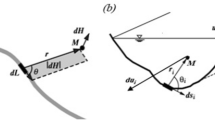Abstract
Evaluation of flow resistance is necessary for the computation of conveyance capacity in open channels. The significance of the friction factor in channels with bedload conditions is paramount. The response of flow resistance in gravel-bed channels in bedload transport conditions is distinct from that of a fixed bed. The paper studies the different empirical approaches in the literature to determine the friction factor under bedload transport conditions and proposes an expression by genetic programming for the same. Various hydraulic and geometric parameters affect flow resistance in the bedload transport condition. The present study includes bed slope, relative submergence depth, aspect ratio, Reynolds number, and Froude number as influencing factors for such flow conditions. A wide range of experimental datasets is employed to determine the effect of these influencing parameters and develop a customised single expression for the friction factor. The experimental data set has also been moderated for sidewall corrections. The predictability of the proposed model is compared to various empirical equations from the literature. Unlike the existing models, the proposed model provides a more extensive expression for effectively predicting the friction factor for a wide range of datasets. The conveyance capacity of a river is validated from the estimated value of friction factor, as compared to other standard models. The developed Multi-Gene Genetic Programming (MGGP) model reasonably predicts discharge in the rivers, signifying that the model can competently be applied to field study within the specified range of parameters.










Similar content being viewed by others
Availability of Data and Materials
All data, models, and code generated or used during the study appear in the submitted article. In detail, data can be found in the relevant literature.
References
Amershi S et al (2019) Software engineering for machine learning: A case study. IEEE/ACM 41st International Conference on Software Engineering: Software Engineering in Practice (ICSE-SEIP), Montreal, QC, Canada, pp. 291–300. https://doi.org/10.1109/ICSE-SEIP.2019.00042
Azamathulla HM (2012) Gene expression programming for prediction of scour depth downstream of sills. J Hydrol 460:156–159
Azamathulla HM, Ahmad Z (2015) Closure to “Estimation of critical velocity for slurry transport through pipeline using adaptive neuro-fuzzy interference system and gene-expression programming” by H. Md. Azamathulla and Z. Ahmad. J Pipeline Syst Eng Pract 6(1):07014004
Azamathulla HM, Ahmad Z, Ghani AA (2013) An expert system for predicting Manning’s roughness coefficient in open channels by using gene expression programming. Neural Comput Appl 23(5):1343–1349
Azamathulla HM, Ghani AA (2010) ANFIS-based approach for predicting the scour depth at culvert outlets. J Pipeline Syst Eng Pract 2(1):35–40
Bathurst JC, Graf WH, Cao HH (1982) Bedforms and flow resistance in steep gravel-bed channels, paper presented at Euromech 156: Mechanism of Sediment Transport. Eur Mech Soc, Istanbul, Turkey
Bogardi J, Yen CH (1939) Tractation of pebbles by flowing water. State Univeristy of Iowa
Campbell L, McEwan I, Nikora VI, Pokrajac D, Gallagher M, Manes C (2005) Bed-load effects on hydrodynamics of rough-bed open-channel flows. J Hydraul Eng 131(7):576–585
Cao HH (1985) Resistance hydraulique d'un lit à gravier mobile à pente raide; étude expérimentale. PhD thesis. Ecole PolytechniqueFederale de Lausane, Lausanne
Carbonneau P, Bergeron NE (2000) The effect of bedload transport on mean and turbulent flow properties. Geomorphology 35:267–278
Casey HJ (1935) Uber geschiebebewegung. Mitt. der Preuss. Versuchanst. Berlin: Wasserbauund Schifiau
Das BS, Devi K, Khatua KK (2019) Prediction of discharge in converging and diverging compound channel by gene expression programming. ISH J Hydraul Eng 1–11
Das BS, Devi K, Khatua KK (2021) Prediction of discharge in converging and diverging compound channel by gene expression programming. ISH J Hydraul Eng 27(4):385–395
Das BS, Devi K, Khuntia JR, Khatua KK (2020) Discharge estimation in converging and diverging compound open channels by using adaptive neuro-fuzzy inference system. Can J Civ Eng 47(12):1327–1344
Ebtehaj I, Bonakdari H (2014) Performance evaluation of adaptive neural fuzzy inference system for sediment transport in sewers. Water Resour Manag 28:4765–4779
Einstein HA, Barbarossa NL (1951) River channel roughness. Am Soc Civil Eng Paper N°2528:1121–1146
Engelund F, Hansen E (1966) A monograph on sediment transport in alluvial streams. Technical University of Denmark, T. Forlag, editor. pp 62
Ferreira C (2001) Gene expression programming: A new adaptive algorithm for solving problems. Complex Systems 13(2):87–129
Fisher D, Ling Xu, Carnes JR, Reich Y, Fenves J, Chen J, Shiavi R, Biswas G, Weinberg J (1993) Applying AI clustering to engineering tasks. IEEE Expert 8(6):51–60. https://doi.org/10.1109/64.248353
Gandomi AH, Alavi AH, Mirzahosseini MR, Nejad FM (2011) Non-linear genetic-based models for prediction of flow number of asphalt mixtures. J Mater Civil Eng 23(3):248–263. https://doi.org/10.1061/(ASCE)MT
Gao P, Abrahams AD (2004) Bedload transport resistance in rough open-channel flows. Earth Surf Proc Land 29(4):423–435
Gilbert GK (1914) The transportation of debris by running water: US Geol. Survey Prof Pap 86:263
Giustolisi O, Doglioni A, Laucelli D (2008) determination of friction factor for corrugated drains. Proc Inst Civil Eng-Water Manag 161(1):31–42. Thomas Telford Ltd
Graf WH, Suszka L (1987) Sediment transport in steep channels. J Hydrosci Hydraul Eng 5(1):11–26
Ho PY (1939) Abhangigkeit der Geschiebebewegung von der Kornform und der Temperature, Preuss. Versuchsanst. fur Wasserbau und Schifibau, Berlin, 37, 43 pp
Hu S, Abrahams AD (2004) Resistance to overland flow due to bedload transport on plane mobile beds. Earth Surf Process Landf J Br Geomorphol Res Group 29(13):1691–1701
Hu S, Abrahams AD (2005) The effect of bed mobility on resistance to overland flow. Earth Surf Process Landf J Br Geomorphol Res Group 30(11):1461–1470
Jiao P, Alavi AH (2020) Artificial intelligence in seismology: Advent, performance and future trends. Geosci Front 11(3):739–744. ISSN 1674–9871
Julien PY (2002) River mechanics. Cambridge University Press, Cambridge, United Kingdom, New York
Julien PY (2010) Erosion and sedimentation, 2nd edn. Cambridge University Press, Cambridge, United Kingdom
Keulegan GB (1938) Laws of turbulent flow in open channels. J Res Natl Bur Stand 21
Khozani et al (2017) An expert system for predicting shear stress distribution in circular open channels using gene expression programming. Water Sci Eng 11(2):167–176
Khuntia JR, Devi K, Khatua KK (2018) Boundary shear stress distribution in straight compound channel flow using artificial neural network. J Hydrol Eng 23(5):04018014
Khuntia JR, Devi K, Khatua KK (2019) Flow distribution in a compound channel using an artificial neural network. Sustain Water Resour Manag 5(4):1847–1858
Kumar S, Khuntia JR, Khatua KK (2021) Prediction of flow resistance in an open channel over movable beds using artificial neural network. J Hydrol Eng 26(5):04021015
Mahdavi A, Omid M (2004) The effect of bed roughness on velocity profile in open channels. River Flow, Napple, pp 295–300
Mavis FT, Liu T, Soucek E (1937) The transportation of detritus by flowing water. Univ. of Iowa, USA, Iowa City, IA
Meyer-Peter E, Muller R (1948) Formulas for bed-load transport. IAHSR Stockholm 39–64
Nikuradse J (1933) Strömungsgesetze in rauhen Rohren. Forsch Arab Ing Wes 36
Omid M, Mahdavi A, Narayanan R (2003) Effects of bedload transport on flow resistance in rigid boundary channels. IAHR, editor. IAHR Tessalonic 641–646
Ostad-Ali-Askari K, Shayan M (2021) Subsurface drain spacing in the unsteady conditions by HYDRUS-3D and artificial neural networks. Arab J Geosci 14(18):1–14
Ostad-Ali-Askari K, Shayannejad M, Ghorbanizadeh-Kharazi H (2017) Artificial neural network for modeling nitrate pollution of groundwater in marginal area of Zayandeh-rood River, Isfahan, Iran. KSCE J Civ Eng 21(1):134–140
Paintal AS (1971) A stochastic model of bed load transport. J Hydraul Res 9(4):527–554
Pradhan A, Khatua KK (2018) Gene-expression programming to predict manning’s n in meandering flows. Can J Civ Eng 45:304–313. https://doi.org/10.1139/cjce-2016-0569
Recking A (2006) An Experimental Study of Grain sorting effects on bedload. Doctoral dissertation. French engineering university– INSA Lyon, France
Recking A, Frey P, Paquier A, Belleudy P, Champagne JY (2008) Bed-load transport flume experiments on steep slopes. J Hydraul Eng 134(9)
Rickenmann D (1990) The bedload transport capacity of slurry flows at steep slopes Doctoral dissertation, ETH Zurich, Switzerland
Salem AK, Imam YE, Ghanem AH, Bazaraa AS (2022) Genetic algorithm based model for optimal selection of open channel design parameters. Water Resour Manag 1–30
Schlichting H (1979) Boundary Layer Theory, 7th edn. McGraw- Hill, New York
Smart G, Jaeggi M (1983) Sediment transport on steep slopes. Mitteilungen der Versuchsanstalt für Wasserbau, Hydrologie und Glaziologie, Zurich, Switzerland
Song T, Graf WH, Lemmin U (1995) Uniform flow in open channels with a movable gravel bed. J Hydraul Res 32(6):861–875
Song T, Chiew YM, Chin CO (1998) Effects of bedload movement on flow friction factor. J Hydraul Eng 124(2):165–175
Tayfur G (2021) Empirical, numerical, and soft modelling approaches for non-cohesive sediment transport. Environ Process 8(1):37–58
van Rijn LC (1982) Equivalent roughness of alluvial bed. J Hydraul Div 108(10):1215–1218
Vanoni VA, Brooks NH (1975) Laboratory studies of the roughness and suspended load of alluvial streams, sedimentation lab. Calif. Inst. of Tech., Pasadena, Calif., Report, No. E, 68, 76
Wiberg PL, Rubin DM (1989) Bed roughness produced by saltating sediment. J Geophys Res Oceans 94(C4):5011–5016
Wong M, Parker G (2006) Re-analysis and correction of bedload relation of Meyer-Peter and Muller using their own database. J Hydraul Engng 132:1159–1168
Wu W, Wang S-Y (1999) Movable bed roughness in alluvial rivers. J Hydraul Eng 125(12):1309–1312
Yen BC (2002) Open channel flow resistance. J Hydraul Eng 128(1):20–39
Author information
Authors and Affiliations
Contributions
Satish Kumar – Primary author for the manuscript and conducted the entire experimental work and mathematical modelling. Arpan Pradhan – The author assisted in applying the Multi-Gene Genetic Programming for Modelling and equally contributed in revision in manuscript.
Jnana Ranjan Khuntia – The author assisted in providing a sound Literature survey, drafting and formatting the manuscript and equally contributed in revision in manuscript. Kishanjit Kumar Khatua – The supervisor and author assisted in providing Technical and Language corrections to the manuscript.
Corresponding author
Ethics declarations
Ethical Approval
Not applicable.
Consent to Participate
Not applicable.
Consent to Publish
Not applicable.
Conflicts of Interest
The authors declare no conflict of interest.
Additional information
Publisher's Note
Springer Nature remains neutral with regard to jurisdictional claims in published maps and institutional affiliations.
Rights and permissions
Springer Nature or its licensor (e.g. a society or other partner) holds exclusive rights to this article under a publishing agreement with the author(s) or other rightsholder(s); author self-archiving of the accepted manuscript version of this article is solely governed by the terms of such publishing agreement and applicable law.
About this article
Cite this article
Kumar, S., Pradhan, A., Khuntia, J.R. et al. Evaluation of Flow Resistance using Multi-Gene Genetic Programming for Bed-load Transport in Gravel-bed Channels. Water Resour Manage 37, 2945–2967 (2023). https://doi.org/10.1007/s11269-022-03409-5
Received:
Accepted:
Published:
Issue Date:
DOI: https://doi.org/10.1007/s11269-022-03409-5




